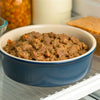Which Wet Food is Best for Dogs? A Comprehensive Guide for Pet Owners
- Houndsy
Table of Contents
- Introduction
- Understanding Wet Dog Food
- Key Considerations When Choosing Wet Dog Food
- Recommended Wet Dog Foods
- Elevating the Feeding Experience with Houndsy
- Conclusion
- Frequently Asked Questions (FAQs)
Introduction
Did you know that nearly 70% of dog owners have reported their dogs preferring wet food over dry kibble? If you’ve noticed your furry friend’s enthusiasm for the aromatic, fulfilling nature of wet food, you are not alone! This intriguing statistic highlights a common truth among pet owners—that moisture-rich, palatable foods can significantly enhance a dog’s meal experience.
As pet lovers ourselves here at Houndsy, we understand how critical it is to provide not just any food, but the right food that meets your dog’s unique dietary needs. Wet food can play a vital role in daily nutrition, especially for dogs who might face challenges eating dry kibble due to age, dental issues, or simply finicky eating habits. In this post, we aim to explore the ideal wet food options available for dogs, providing insights into what makes a wet food choice worth considering while integrating tips from our brand philosophy of enhancing everyday pet care.
By the end of this article, you will learn:
- The nutritional characteristics and benefits of wet dog food.
- Key factors to consider when choosing the best wet food for your dog.
- Recommended brands and options based on varying life stages and dietary needs.
- How to elevate your pet's mealtime experience with innovative products like the Houndsy Kibble Dispenser.
Let’s embark on this journey together, as we navigate the wet food landscape tailored for our beloved canine companions!
Understanding Wet Dog Food
What is Wet Dog Food?
Wet dog food, typically found in cans or pouches, contains a significant amount of moisture—usually ranging from 75% to 85% water. This high moisture content is appealing to dogs, as it not only enhances the aroma and flavor but also aids in hydration, particularly beneficial for dogs that are not avid drinkers or those susceptible to urinary issues.
Nutritional Benefits
Opting for the right wet dog food can provide numerous advantages:
- Increased Palatability: The rich taste and aroma often entice even the pickiest eaters, making meal times more enjoyable.
- Enhanced Hydration: The high water content contributes to your dog's overall water intake and can assist those who need additional hydration.
- Easier Digestion: Many dogs, especially seniors or those with dental problems, may find wet food easier to chew and swallow, which can help to digest their meals more effectively.
Research has shown that wet dog food can also boast a higher protein to carbohydrate ratio compared to dry kibble, thus offering additional benefits such as supporting lean muscle development.
Common Myths About Wet Dog Food
While wet dog food is generally considered nutritious, there are some myths that we’d like to debunk:
- Myth: Wet food is less nutritious than dry food. While this can vary by brand, many wet foods contain high-quality ingredients and meet the AAFCO standards for nutrition. Always read labels!
- Myth: Wet food causes excess weight gain. When monitored properly, feeding a dog wet food in moderation can help maintain a healthy weight. The key lies in understanding their daily caloric needs based on activity level.
Key Considerations When Choosing Wet Dog Food
When selecting the best wet food for dogs, we should consider several factors—aimed at ensuring your pup receives the most suitable dietary options. Here are the critical areas to focus on:
Ingredient Quality
Ensure that the wet food you select has high-quality, recognizable ingredients:
- Named Proteins: Ingredients should list a specific meat source (e.g., chicken, beef) as the first ingredient.
- Limited Fillers: Ideally, the food should contain minimal fillers like corn or soy, as these don’t contribute nutritional value.
Nutritional Adequacy
Look for products that comply with the standards set by the AAFCO—all reputable brands should align their formulas with these nutrient profiles for complete and balanced diets.
Life Stage Appropriateness
Different life stages require different nutritional profiles:
- Puppies: Require higher protein and fat for growth and energy.
- Adult Dogs: Should receive a balanced diet that sustains their energy levels and maintains a healthy weight.
- Senior Dogs: May require lower protein levels and easily digestible ingredients to accommodate a less active lifestyle.
Health Considerations
If your dog has health issues (like diabetes or kidney problems), consulting with your veterinarian about suitable wet food options is crucial. Many brands offer specialized formulas catering to specific health needs.
Brand Reputation
Select brands recognized for their commitment to ingredient quality and transparency. Brands that frequently test their products for safety and adhere to ethical sourcing practices can often be trusted.
Recommended Wet Dog Foods
Now that we’ve covered the fundamental aspects of wet dog food, let’s delve into several brands and options that stand out in the market for their quality, nutritional value, and palatability for your pup.
1. Open Farm
Open Farm focuses on sourcing ethical, human-grade ingredients from certified farms. Their products are ideal for dogs who require a diet that’s both nutritious and easily digestible.
- Best For: Dogs of all ages.
- Key Features: Ethically sourced proteins, non-GMO veggies, and grain-free options.
2. The Farmer’s Dog
The Farmer's Dog offers fresh, human-grade meals tailored to your dog’s unique dietary needs—with customizable options based on each dog’s age, breed, and activity level.
- Best For: Puppies and adult dogs needing precise nutritional requirements.
- Key Features: Frozen meals delivered directly to your home, ensuring freshness.
3. Weruva
Known for their high-quality, moisture-rich stews, Weruva focuses on providing simple, recognizable ingredients. Many of their products are free from grains and fillers.
- Best For: Senior dogs or those with sensitive stomachs.
- Key Features: Recognizable meat chunks and gentle on digestion.
4. Merrick Grain-Free Wet Dog Food
Similar to their dry food counterparts, Merrick's grain-free wet options are loaded with lean proteins and fresh produce, giving dogs a taste of home-cooked meals.
- Best For: Food-sensitive dogs.
- Key Features: Grain-free formulas, high protein content, and no artificial preservatives.
5. Hill's Science Diet
Recommended by veterinarians, Hill's Science Diet provides scientifically formulated diets based on extensive research, addressing various health issues.
- Best For: Dogs with specific health conditions.
- Key Features: Veterinary-endorsed, tailored nutrition for specific health needs.
Elevating the Feeding Experience with Houndsy
At Houndsy, we believe that mealtime should be an enjoyable experience for both you and your dog. That's why our flagship product, the Houndsy Kibble Dispenser, is designed with innovative features to simplify and elevate the dog-feeding ritual:
- Perfect Portion Control: Serving the right amount of wet food could promote better eating habits.
- Ergonomic Design: The convenient crank allows for easy dispensing at standing height—no more bending down to scoop food!
- Stylish Appearance: Our dispenser showcases a mid-century modern design that complements your home décor while keeping your dog's feeding area attractive.
To truly enhance your dog's feeding experience, we invite you to explore the Houndsy Kibble Dispenser.
Conclusion
Choosing the best wet food for your dog can significantly enhance their nutritional intake and overall wellbeing. By focusing on quality ingredients, considering life stages and health requirements, and selecting trusted brands, you can create a well-rounded diet tailored to your furry friend.
As you navigate the variety of options available, do take a moment to reflect on your dog’s individual needs and preferences. Whether they’re a playful puppy or a wise senior, we can ensure they receive the nourishment they deserve, leading to healthier and happier days together.
What wet food has your dog enjoyed the most? Have you considered integrating a convenient dispensing solution like the Houndsy Kibble Dispenser to streamline your feeding routine? We’d love to hear your thoughts!
Frequently Asked Questions (FAQs)
1. Is wet dog food better than dry? While both forms of dog food have their benefits, wet dog food is often more palatable and hydrating, making it an excellent option for picky eaters or dogs with certain health issues.
2. Can I mix wet and dry dog food? Yes, many pet owners successfully mix wet and dry food. This combo can enhance flavor while providing the benefits of both food types.
3. Is it safe to feed my dog canned food every day? Consulting your veterinarian regarding your dog’s dietary needs is crucial. Regular canned food can be part of a balanced diet if it meets nutritional standards.
4. What do I look for in good wet dog food? Look for named proteins as the primary ingredient, minimal fillers, adherence to AAFCO standards, and options formulated for your dog’s life stage and health needs.
5. How do I transition my dog to new wet food? Gradually mix the new wet food with their current food over a period of 7 to 10 days to prevent digestive upset, increasing the new food amount each day.
We hope this guide helps you navigate the world of wet dog food better. Remember, choosing the right food is an essential part of caring for our furry family members!












